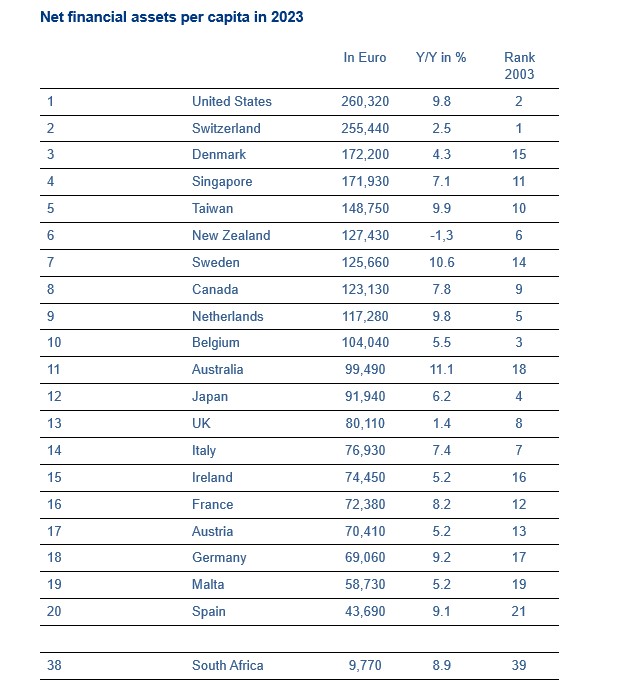Allianz unveiled the 15th edition of its “Global Wealth Report“, which puts the asset and debt situation of households in almost 60 countries under the microscope.
Surprising relief
2023 was marked by sharp monetary tightening. But economies proved resilient and markets even boomed. Against this backdrop, global financial assets[1] of private households recorded strong growth: With an increase of 7.6%, the losses of the previous year (-3.5%) were more than made up for. Overall, total financial assets amounted to EUR 239 trillion at the end of 2023.
Growth in the three major asset classes was quite uneven. Securities (11.0%) and insurance/pensions (6.2%) benefited from the stock market boom and higher rates and grew significantly faster than the average of the last ten years. In contrast, growth in bank deposits fell to 4.6% after the pandemic-related boom years, recording one of the lowest increases in the last 20 years.
The recovery in 2023 was broad-based. In fact, only two countries – New Zealand and Thailand – recorded negative growth rates. Moreover, growth was relatively uniform across all regions, not least in Asia and North America, which both grew by over 8% – with the USA (8.6%) growing even more strongly than China (8.2%). As a result, the growth advantage of the emerging economies over the advanced economies has shrunk significantly again, amounting to just 2pp last year; in six of the last seven years, emerging economies have largely lost their growth lead.
“The comparatively weaker growth of poorer countries reflects the new reality of a fragmenting world,” said Ludovic Subran, chief economist of Allianz, which provides commercial, travel and trade credit insurance in South Africa. “Until 2017, the year in which the trade disputes between the USA and China broke out, poorer countries still had a growth advantage of 10 percentage points or more over richer countries.. We will all pay a price for decoupling but it is the emerging economies that will feel it most. A less connected world is a more unequal world.”
No place for bank deposits
In 2023, the normalization of fresh savings continued after the pandemic-related boom years of forced savings: They fell by 19.3% to EUR 3.0 trillion. This decline was almost exclusively attributable to bank deposits. On balance, banks worldwide only received EUR 19bn, a slump of 97.7%.
The main culprit: US households who liquidated deposits worth EUR 650bn. The other two asset classes, on the other hand, remained popular with savers. Inflows into securities even increased once again by 10.0%. However, there was a notable change of favorites within this asset class: while shares were sold on balance in many markets, savers made strong gains in bonds, thanks to the turnaround in interest rates. And insurance/pensions proved to be relatively robust, with the decline in fresh savings worldwide amounting to just 4.9%.
Expected restraint
While financial assets shrugged off the interest rate turnaround, it had a clear impact on the liabilities side of private households’ balance sheets in 2023: Growth in private debt weakened further to 4.1% worldwide, the lowest growth in nine years. Overall, the global liabilities of private households amounted to EUR 57trn at the end of 2023.
The decline in debt growth was observed in almost all regions in 2023. It was particularly pronounced in Western Europe and North America, where growth more than halved to 1.1% and 2.9%, respectively. As nominal growth in global economic activity remained elevated by inflation, the global debt ratio (liabilities as a percentage of GDP) fell for the third year in a row, dropping by 1.5 pp to 65.4%. This was also more than three percent lower than 20 years ago.
Relatively strong growth in assets and relatively weak growth in liabilities led to a significant increase of 8.8% in global net financial assets (financial assets less liabilities). Overall, global net financial assets amounted to EUR 182trn at the end of 2023; this represents an increase of almost EUR 15trn compared to the previous year and is also EUR 4trn above the previous record value from 2021.
Setback
The other asset class that suffered from rising interest rates was real estate. It recorded the lowest growth in 10 years, advancing by only 1.8%; in Western Europe, it fell by 2.2%. But also in the past, the growth rates of real estate have lagged in most markets behind those of financial assets; in North America, for example, the annual gap was almost one percent over the last two decades, reflecting the fact that long-run capital gains for real estate are lower than those for equities.
But the future is likely to be even more challenging, given the increasing impact of climate change on real estate assets. Although natural catastrophes dominate the headlines, the costs of the transition to climate friendly buildings (so-called transitions risks) will have the bigger impact in the long run.
Projections of the House Price Index (HPI) under different climate scenarios up to 2050 show declines of 20% or more for many markets. For all markets under consideration, the value of real estate could be EUR 30trn lower.
“In future, housing prices are set to be defined equally by location and by energy efficiency,” said Hazem Krichene, co-author of the report. “But while higher physical risks are unavoidable, transitions risks are not: they are the results of policy decisions. Australia shows the way. An ambitious climate policies could lead to a sharp decline in energy consumption, minimizing the impact on housing prices. The potential big losses in other markets are a clear call for an efficient and effective climate policy. It’s still not too late.”
South Africa: Return to robust growth
Financial assets of South African households increased by 8.3% in 2023, posting a strong recovery after the dismal year of 2022 (+0.1%). Main driver were insurance/pensions (9.5%) which is also the dominant asset class in South African households’ portfolio (share of 49%). But also the two other asset classes showed solid growth, bank deposits increased by 7.5% and securities by 7.0%.
The picture is less rosy in real terms: Adjusted for inflation, financial assets increased by only 2.2% in 2023. Compared to the pre-pandemic level of 2019, however, the purchasing power of financial assets was 12.3% higher at the end of 2023. This is in sharp contrast to many European economies where savers suffered four lost years in real terms.
While growth in financial assets is solid, distribution remains the Achilles heel of South Africa. In fact, it is one of the countries with the most unequal distribution of wealth, with the richest 10% of the population owing 85% of total net financial assets. Moreover, over the last two decades the situation has hardly improved.
In line with the global trend, growth in liabilities slowed to 5.6% in 2023. The debt ratio, however, remained at 41%, i.e. at the pre-pandemic level and eight percent below the record of 2007. Net financial assets, finally, advanced by a robust 8.9%. With net financial assets per capita of EUR 9,770, South Africa climbed one rung to 38th place in the ranking of the 20 richest countries (see table).


























